
SCP-1928
The Family Banjo
Connected to: SCP-1890SCP-1896

Photo of SCP-1928 copied from SCP-1890
Special Containment Procedures
SCP-1928 should be kept in a padded, airtight case to prevent damage or accidental activation of anomalous properties.
This artifact is stored at Research Sector-09 as a part of the Bonifay family collection. Cross-testing of SCP-1928 with SCP-1890 and SCP-1896 has been suspended, pending further study of Incident Times-Union (see Addendum 2).
Description
SCP-1928 is a banjo uke or “banjolele”, identical to a discontinued brand originally mass-manufactured in the 1920s.
When strummed or tapped with only one hand, SCP-1928 produces sounds comparable to a non-anomalous instrument. However, when a human subject places both hands on any part of the artifact, they will be compelled to play it. Except in cases of disability or manual impairment, subjects affected by SCP-1928 demonstrate consistently superior technique and speed in various styles of strumming and fingerpicking.
No audible sound is produced by this compulsive playing. In-person observation and audio recordings have only reported the sounds of the affected subjects' breathing or the rustle of their clothing.
Tested subjects describe their movements as involuntary; while affected, however, subjects’ facial cues and body language suggest intent concentration or thoughtfulness. While under the influence of SCP-1928, subjects will not respond to visual or auditory stimuli, only returning to full consciousness if another individual comes into physical contact with SCP-1928.
Six images of SCP-1928, identified by distinctive scratches and the capital "BON" scratched on the back of the head, have been found in SCP-1890. The instrument is pictured in the hands of individuals of different ethnicities and ages, or placed on display with other valued possessions.
Addendum 2:
Some time after the observation of SCP-1928's secondary effect, approval was granted for cross-testing of the "Bonifay family" artifacts— SCP-1928, SCP-1890, and SCP-1896 —in an effort to learn more about the seemingly interrelated history and nature of these items. Incident Times-Union describes the textual and photographic alterations that occurred as a result of these experiments.
